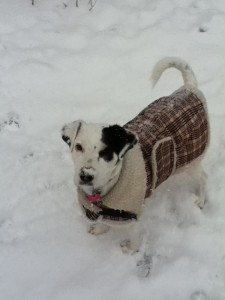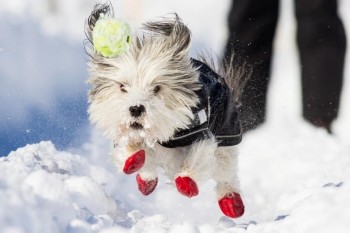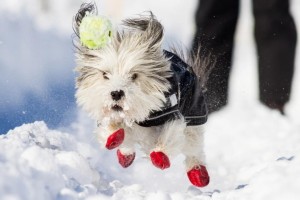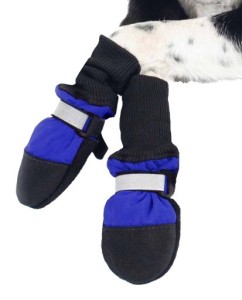Baby It’s Cold Outside! Cold Weather Tips For Your Pets
Even though Ontario’s own Wiarton Willie says we’ll have an early spring this year, the cold weather is here for now, and many people have questions about how to make sure their pets stay comfortable and safe during the winter months. Here are a few tips for common concerns when it’s cold outside.
Does My Dog Or Cat Really Need A Coat?
 It’s not uncommon these days to see dogs and even cats wearing coats and/or sweaters during the winter. However, that doesn’t mean that you won’t get the odd comment from those who believe that clothing is for humans, not for pets. So, who’s right? The answer is that whether your pet requires outerwear for the season, or not, depends entirely on the individual pet. For example, if you own a Husky, Alaskan Malamute, or any other Northern breed dog or mix, your dog may have a coat that was designed specifically to stand up to very cold temperatures – especially if the dog is outside often and has a chance to grow in a thick, fluffy undercoat in response to the climate. Similarly, breeds like Labrador retrievers were bred to have a thicker layer of fat under the skin, along with a coat that readily repels moisture, providing them with a bit more insulation against the cold. However, many breeds, including many mixed breed dogs and cats, may not have a coat that is thick enough to withstand extreme weather, or enough subcutaneous fat to insulate them. Additionally, many breeds of dog have a very fine or short fur coat, and they may have no fur at all on their lower belly and their legs. In cases like these, a good winter coat or a nice, thick sweater is a great investment for your pet. If you are experiencing a lot of precipitation this winter, look for outer wear that is moisture-proof, as snow can soak through to the pet’s fur and create more cold by forming ice.Other factors to consider when deciding whether to outfit your pet in winter wear include:
It’s not uncommon these days to see dogs and even cats wearing coats and/or sweaters during the winter. However, that doesn’t mean that you won’t get the odd comment from those who believe that clothing is for humans, not for pets. So, who’s right? The answer is that whether your pet requires outerwear for the season, or not, depends entirely on the individual pet. For example, if you own a Husky, Alaskan Malamute, or any other Northern breed dog or mix, your dog may have a coat that was designed specifically to stand up to very cold temperatures – especially if the dog is outside often and has a chance to grow in a thick, fluffy undercoat in response to the climate. Similarly, breeds like Labrador retrievers were bred to have a thicker layer of fat under the skin, along with a coat that readily repels moisture, providing them with a bit more insulation against the cold. However, many breeds, including many mixed breed dogs and cats, may not have a coat that is thick enough to withstand extreme weather, or enough subcutaneous fat to insulate them. Additionally, many breeds of dog have a very fine or short fur coat, and they may have no fur at all on their lower belly and their legs. In cases like these, a good winter coat or a nice, thick sweater is a great investment for your pet. If you are experiencing a lot of precipitation this winter, look for outer wear that is moisture-proof, as snow can soak through to the pet’s fur and create more cold by forming ice.Other factors to consider when deciding whether to outfit your pet in winter wear include:
- Your pet’s age. Pets that are older, or pets that are very young – especially puppies and kittens under 8 weeks of age – may not tolerate cold well.
- Your pet’s overall health. Pets that are ill, have chronic medical issues, or are underweight may show an intolerance for cold weather
- Your pet’s diet and exercise level. If you and your pet spend a great deal of time outside in very cold weather, and if your pet is getting a lot of exercise during this time, they may need more calories in their diet, as their body will be working hard to maintain heat. If this is the case, speak to your veterinarian about adjusting your pet’s diet – overfeeding incorrectly may cause your pet to become ill.
- Your pet’s breed, again. While some breeds are especially well-suited to very cold weather, there are also breeds that do more poorly in the cold. Sight hound breeds, such as Greyhounds, Italian Greyhounds, and Whippets have a very thin layer of fat under the skin, and these dogs will require extra attention in very cold weather to ensure their safety.
What About Booties, Does My Pet Need Those?
You may have begun to see more dogs in your area wearing booties while out for a walk with their owner (cats can wear booties as well, however, owners may have a difficult time keeping the booties on the cat!). Booties are an excellent idea for dogs, particularly those who live in areas where the sidewalks are highly salted. The concern is that the salt and ice on the sidewalks and roads can cause abrasions and severe dryness; using booties can prevent a lot of damage to your dog’s paw pads (which may be more or less sensitive, depending on the breed – again, Northern breed dogs may have thicker paw pads that are more resistant to cold weather extremes). There are a variety of different brands of booties that you can try with your dog, but most of them fall into one of two categories. There is the bootie that looks like a small version of an actual boot that a person would wear – these are normally made of tougher, weather-resistant fabric and rubberized bottoms that provide extra grip, and they typically have Velcro fastenings at the top to allow owners to adjust the tightness needed to keep the booties on. There is also the “balloon” type bootie, which looks just as it sounds – these are a simple piece of rubber, which looks like a (somewhat sturdy) deflated balloon, which owners simply slip on to cover the foot. Both types of booties can provide excellent protection for the paw pads. There is no “good” or “bad” version of dog booties, there is just the bootie that your dog tolerates better. Some dogs have a difficult time acclimating to the feel of the first type of bootie, and spend most of their walk time trying to remove these, either with their teeth or by kicking their legs out. However, the rubber balloon booties may not provide enough warmth or coverage for your dog’s feet, though your dog may have a much higher tolerance for keeping them on. A bit of trial and error is to be expected with these, but either way, you can rest assured that your dog’s feet will be better for having worn booties!
Note: an alternative to pet booties is to purchase a balm or wax designed for your pet’s feet. This type of product is available in many places now, and can offer a bit of a barrier to excess moisture and salt on the pavement. However, these products may or may not be as effective as booties, which provide a thicker layer of protection on your pet’s feet – and make sure you check the product when you purchase it to ensure that it is guaranteed to not stain household carpets and other fabrics.
So, How Cold Is Too Cold For My Pet?
 To answer this question, look to your pet, because once again it depends on the individual. Does your pet look miserable when he or she is outside? Do they cry to come into the house? Do they shiver incessantly? When you are out for a walk, does your dog start lifting his or her feet, as if the ground is painful to walk on? All of these responses to the cold are signals that you should bring your pet inside your home, as it has become too cold for them to safely stay outdoors. Pets that are outside for too long in extremely cold weather are in danger of frostbite, or even of freezing to death. As a general guideline, once the temperature dips below the freezing point you should always keep a close eye on your pet when outdoors, and monitor them for signs that they are too cold.
To answer this question, look to your pet, because once again it depends on the individual. Does your pet look miserable when he or she is outside? Do they cry to come into the house? Do they shiver incessantly? When you are out for a walk, does your dog start lifting his or her feet, as if the ground is painful to walk on? All of these responses to the cold are signals that you should bring your pet inside your home, as it has become too cold for them to safely stay outdoors. Pets that are outside for too long in extremely cold weather are in danger of frostbite, or even of freezing to death. As a general guideline, once the temperature dips below the freezing point you should always keep a close eye on your pet when outdoors, and monitor them for signs that they are too cold.
If you have a pet that lives outside regularly, you must construct an adequate shelter for that pet, so that it can stay warm and safe during the coldest weather of the year. This means constructing an enclosure that is elevated above the ground, and also has a roof. The enclosure should be large enough for the animal to be able to move around, but small enough that it won’t allow the pet’s body heat to dissipate into the air around them. You must provide an insulating material for the inside of the enclosure, such as straw, and you must keep this material clean and dry – this requires checking each day to make sure the material has not been soiled or exposed to snow or ice. Plenty of food and non-frozen water must also be readily available to the pet that lives outdoors in winter months. And keep in mind that when inclement weather becomes truly extreme, you may need to find a better, safer way to keep your pet warm, until the weather passes. Even a well-protected pet is still susceptible to frostbite and freezing when the weather reaches a certain point of extreme cold.
What If I See An Animal That Has Been Left Outside?
If you see an animal – be it a dog or a cat – that you suspect has been left outside for too long in very cold weather, please find a way to contact the owners of the pet and let them know about your concerns. If this isn’t possible for any reason, do contact your local animal welfare organizations for assistance, or the police, if necessary. Do not assume that the animal is being cared for. The sad fact is that you could be the only one who has noticed the pet’s suffering, making you the only person who can do something about it.
Are There Any Other Things I Should Know?
Yes! A few more quick tips:
- Don’t let your pet eat snow or consume liquid that is on the ground, in case your pet should consume anti-freeze. Each year, many pets are poisoned because they consume anti-freeze, which has a pleasant, sweet taste to them. Even a very small amount is enough to kill a small animal, so make sure you watch that your pet doesn’t consume any snow or liquids outside that could contain anti-freeze.
- Salt and other de-icing chemicals can make your pet sick. As such, give your pet’s feet a quick rinse when you bring them inside, to ensure that they do not consume anything by licking their feet clean. This issue is avoided when your pet wears booties outside!
- Before you start your car, bang the hood. Cats that are left outside can be very resourceful about finding a warm place to sleep, and that includes right next to your car’s transmission. Starting the car can then injure or kill the cat, so give any cats who have called your engine home for the night a little warning that they should move on.
- The inside of the car is not likely to be warm, unless the day is mild and sunny. Therefore, please do not leave pets in the car – just like in the summer heat, pets are better off left in the safety of their home than with you in the car.
If you have any other question about cold weather safety or products designed for pets in cold weather such as booties, coats or paw protectant waxes, please don’t hesitate to contact us at Wilson Mobile Veterinary Services (wilsonmobilevet@gmail.com or 226-236-7233). We are happy to assist you, and provide veterinary care to your pet within the comfort of your home. We provide veterinary house calls to London, Ontario and surrounding areas such as Lucan, St. Mary’s, Ilderton and Thorndale. We look forward to hearing from you!
Written by: Melissa Harris, RVT.



